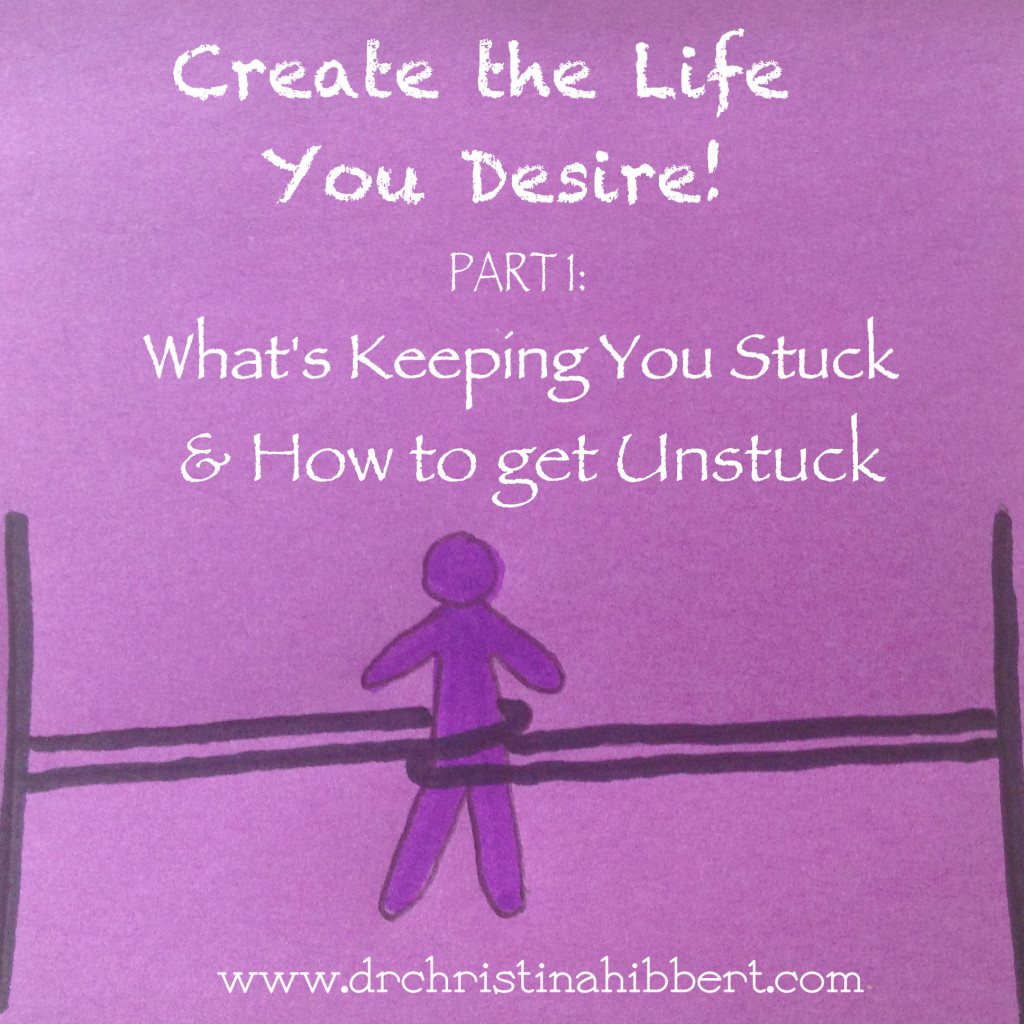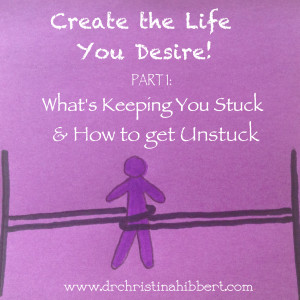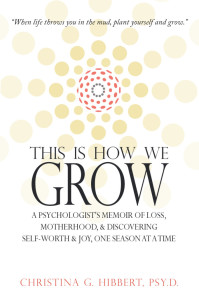
11 Jan Create the Life You Desire! Part 1: What’s Keeping You Stuck & How to Get Unstuck
As I remind myself all the time, there are no problems in life: only situations. It is our perception that turns a situation into a problem.
That being said, we all have many “situations” in our lives we would like to change or wish were different. Over-scheduled, uncertain, overdoing it, under-rested, overly frustrated, under-appreciated, over-it-all, under the covers—whatever your situation may be, you have the power to choose your perception and to create the change that is needed in your life.
The Power to Choose
Too often, however, we allow our thoughts and feelings to rule our minds, hearts and even our spirits. As the clouds roll in, we submit and, like Eyeore, mumble, “Well, it’s going to rain, no chance of sun for me today,” turning back to hide in our cold, dark cave. We fail to embrace our power to choose, to create what we want despite the weather, to grab an umbrella, a sunny raincoat, and polka-dot rain boots and head out to seek our good fortune.
Too often we forget that between feelings, thoughts, and behaviors, we have choice. As holocaust survivor and psychiatrist, Viktor Frankl, wrote, “Between stimulus and response there is a space. In that space is our power to choose our response. In our response lies our growth and our freedom.”[1]
We can choose to use that “space” to promote our growth and freedom—to create and experience the life we desire.
The “Problem”
The problem is (and yes, from my perspective this is a “problem”) we remain stuck in old patterns and habits. And try as we may, it can be very tough to get ourselves “unstuck”. But why is it so hard to get “unstuck”? I’ll tell you: It’s because the fundamental structure of our lives is not the way we need it to be.
I learned this last year, and it has made such a difference in how I approach my life situations: It’s the structure of my life that needs changing, not just the actions and behaviors. As author Robert Fritz explains, “Once a structure exists, energy moves through that structure by the path of least resistance. In other words, energy moves where it is easiest to go”[2]. The energy of our lives moves where it is easiest to go.
Think of it this way: Imagine a river. A river flows according to the underlying structure of the riverbed. So, too, do we “flow” according  to the underlying structure of our lives: “If a riverbed remains unchanged, the water will continue to flow along the path it always has, since that is the most natural route for it to take. If the underlying structures in your life remain unchanged, the greatest tendency is for you to follow the same direction your life has always taken.”[3]
to the underlying structure of our lives: “If a riverbed remains unchanged, the water will continue to flow along the path it always has, since that is the most natural route for it to take. If the underlying structures in your life remain unchanged, the greatest tendency is for you to follow the same direction your life has always taken.”[3]
This is great news if the direction you have taken in your life so far continues to lead you where you desire to be. But for most of us, the structure of our lives keeps us stuck in this pattern of repeating old behaviors only to have them work for a while but ultimately fail.
Feeling “Stuck” in Life Patterns: The Rubber-Band System
So what causes us to remain stuck, even though we work very hard to be “unstuck”? Fritz gives an interesting explanation that I call “the rubber-band system”.
Imagine you are standing in a room, between two walls. Imagine that you have two giant rubber bands around your waist, each stretching to an opposite wall, where it is securely attached. On the wall to your right, you see the words, “I want …” (we’ll use “to get better sleep” for our example). To the wall on your left, you see the words, “I can’t have what I want.”
As you move toward the thing you desire (in this case, better sleep), the tension of the rubber band attached to the “I want to get better sleep” wall loosens while the tension of the rubber band from the other wall grows stronger. Eventually the tension from that other wall becomes so strong, it slings you back in the other direction, toward “I can’t have what I want.” In other words, the more you work on sleeping better (going to bed earlier, reducing distractions, sleeping in when you can), the better sleep you will get (hopefully) and the less tension you will feel about needing better sleep. As you feel less tension about needing better sleep, you are then more likely to stay up later and get up early every day, thus pushing you back toward the “I can’t have what I want” stance and worse sleep.
The Rubber-Bands in Your Life
 Are you with me so far? As you ponder this, you will begin to see all kinds of “rubber bands” in your life. Some examples include: working hard to lose weight only to loosen up on your diet on exercise once you’ve lost that first 10 pounds; enforcing rules in your home in order to have more structure, only to find that you relax once the “structure” is in place and things once again become chaotic (leading to enforcing rules again); or frantically getting rid of clutter and finally being “clutter-free,” only to loosen up and then find your home cluttered again a few months later. These “rubber-band structures” are everywhere once you look. And they are, unfortunately, ultimately unsolvable. They keep us stuck in our “problems.”
Are you with me so far? As you ponder this, you will begin to see all kinds of “rubber bands” in your life. Some examples include: working hard to lose weight only to loosen up on your diet on exercise once you’ve lost that first 10 pounds; enforcing rules in your home in order to have more structure, only to find that you relax once the “structure” is in place and things once again become chaotic (leading to enforcing rules again); or frantically getting rid of clutter and finally being “clutter-free,” only to loosen up and then find your home cluttered again a few months later. These “rubber-band structures” are everywhere once you look. And they are, unfortunately, ultimately unsolvable. They keep us stuck in our “problems.”
Psychologist Carl Jung observed the same phenomenon: “All the greatest and most important problems of life are fundamentally insoluble…. They can never be solved, but only outgrown. This “outgrowth” proved on further investigation to require a new level of consciousness. Some higher or wider interest appeared on the patient’s horizon, and through this broadening of his or her outlook the insoluble problem lost its urgency. It was not solved logically in its own terms but faded when confronted with a new and stronger life urge” (in Fritz, p. 40).
The Solution? Creating!
So what is the solution? What is this “new level of consciousness,” this “new and stronger life urge?” Creating. As Fritz says, “No matter what your problems are, for the most part, solving them won’t solve them. You will always have a new problem if you do not know how to create what you want. And creating is no problem.”
Creating the structure we need for the life we desire is no problem. In fact, it’s the key to a life of growth, freedom, peace, and joy.
So, are you with me in learning how to create the life we desire? Yes?! Then, join me for Part 2: The 3 Steps of Creating. In the meantime, check out the “Ponder This” section below, which has a few suggestions to help you get to work.
I’d also love to know what you think of these ideas, so drop me a note in the comments below or on my Facebook Page. This is deep stuff, I know, but it’s so helpful once we understand it! I’m happy to answer any questions, and I’d love to know what you think so far!
Ponder This: If you really want to create the life you desire, then set aside some time and ask yourself the following questions. Write your answers in a journal or notebook, or discuss with a close friend, partner, or therapist. If you’re willing to do the work, you will see the results! Let me know how it goes by leaving a comment, below!
1) Take some time to ponder the “rubber-bands” in your life. Do you see yourself stuck in the rubber-band system?
2) In what ways are you stuck in the rubber-bands?
3) What are the underlying structures of your life that are keeping you “stuck”?
Be sure to check out Dr. Hibbert’s Amazon Bestseller, This is How We Grow–
available now on Amazon.com!
Join my This is How We Grow Personal Growth Group!
FREE. Online. Growth. What more could you ask for?
Don’t miss a thing!
SUBSCRIBE, below, “like” my Facebook pages (Dr. Christina Hibbert; This Is How We Grow) and follow me on Twitter,Pinterest, & Instagram!
You may manage your subscription options from your profile
Related Posts/Articles
Create the Life You Desire: Part 2, The 3 Steps of Creating
Beyond Resolutions: Discovering Your New Year’s Vision!
40 Physical & Mental Health Benefits of Exercise
Achieving Balance: Why You’ve Got it Wrong, & How to Get it Right
Frustrations & Expectations: 4 Surefire Way to Lower Expectations & Obliterate Frustrations
[1] Frankl, V. (1959). Man’s Search For Meaning.
[2] Fritz, R. (1989). The Path of Least Resistance: Learning to become the creative force in your own life. (p. 4).

